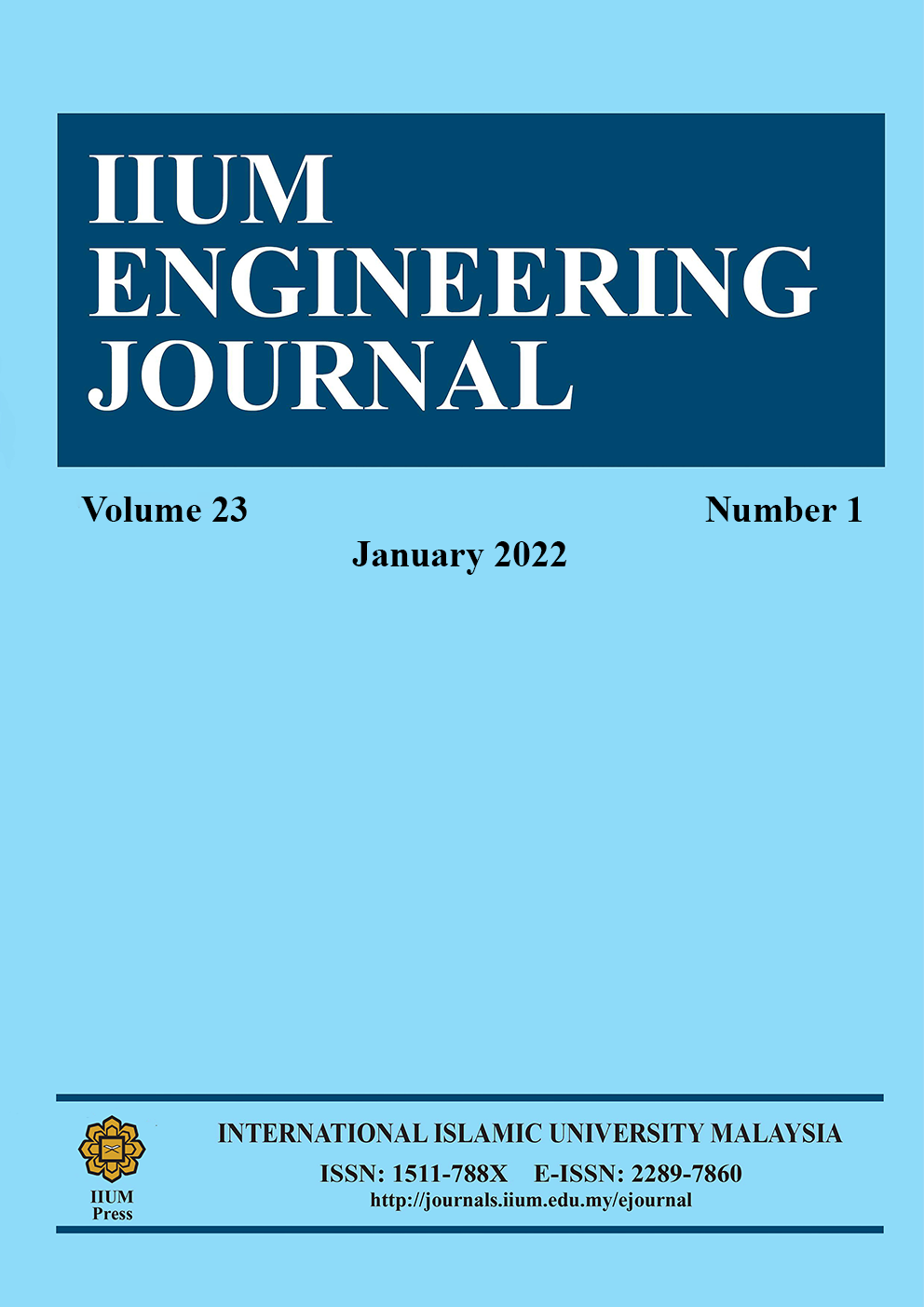COMPARATIVE STUDY ON DEGRADATION OF POLYLACTIC ACID/ SYZYGIUM AROMATICUM COMPOSITES AGEING IN OUTDOOR ENVIRONMENT AND SOIL BURIAL
DOI:
https://doi.org/10.31436/iiumej.v23i1.2138Keywords:
Degradation, Virgin PLA, Recycled PLA, Natural Weathering, Soil BurialAbstract
Major environmental problems resulting from non-degradable components of plastic wastes have awakened great attention to bioplastic as an alternative material. Among various bioplastic materials, polylactic acid (PLA) is recognised as a promising material especially as a food packaging material. The development of PLA composites using various fillers has extensively been in focus in order to preserve the high quality, safety, and extended shelf-life of packed food. Among the interesting fillers is Syzygium aromaticum (SA). SA, also known as clove, has biological activities such as antibacterial, antifungal, insecticidal, and antioxidant properties. This work investigated the effects of SA filler on the degradations of virgin PLA (VPLA) and recycled PLA (RPLA). The VPLA/SA composites and RPLA/SA composites were prepared using the solvent casting method. The content of SA filler varied in the range of 0 to 20 wt%. The composites were aged in outdoor environment and soil burial. The results revealed that the degradation rate was increased with the increase of SA filler in both ageing environments. After 10 weeks of ageing in the outdoor environment, the weight loss of VPLA/SA composites and RPLA/SA composites containing 20 wt% of SA were 7.7% and 12.8% respectively. Whereas in soil burial, the weight loss of VPLA/SA composites and RPLA/SA composites with similar SA content were 25.6% and 38.3% respectively. The degradation rate was observed to be more rapid in the soil burial as compared to the outdoor environment. Comparably, RPLA and RPLA/SA composites experienced higher degradation rates than VPLA and VPLA/SA composites. The degradation rate was consistent with scanning electron microscope (SEM) images which observed the formation of holes, cavities, cleavages, and grooves on the surfaces of the samples. Thermogravimetric analysis (TGA) results on aged samples showed that VPLA/SA composites and RPLA/SA composites that had aged in soil burial decomposed at lower temperatures. The shortening of degradation time of the VPLA/SA composites and RPLA/SA composites could increase their potential to be used as food packaging materials.
ABSTRAK: Masalah utama terhadap alam sekitar yang disebabkan oleh sisa plastik yang sukar terurai, telah menarik perhatian terhadap bioplastik sebagai bahan alternatif. Di antara pelbagai jenis bahan bioplastik sedia ada, asid polilaktik(PLA) dilihat sebagai bahan yang paling sesuai terutamanya sebagai bahan pembungkusan makanan. Perkembangan di dalam penghasilan komposit asid polilaktik yang ditambah dengan pelbagai bahan pengisi telah menjadi fokus terutamanya bagi tujuan meningkatkan kualiti, kesegaran dan jangka hayat makanan. Salah satu pengisi yang mendapat perhatian adalah Syzygium aromaticum (SA). SA yang juga dikenali sebagai bunga cengkeh mempunyai aktiviti biologi, seperti sifat antibakteria, antijamur, racun serangga dan antioksidan yang tinggi. Didalam kajian ini, siasatan terhadap kesan penambahan SA terhadap penguraian PLA asal (VPLA) dan PLA kitar semula (VPLA). Komposit VPLA/SA dan komposit RPLA/SA disediakan dengan menggunakan kaedah pelarutan pelarut. Kandungan pengisi SA adalah didalam julat 0 – 20% mengikut berat. Komposit tersebut dibiarkan menua didalam persekitaran luaran dan didalam tanah. Keputusan kajian mendapati bahawa kadar penguraian semakin meningkat dengan penambahan peratus berat bahan pengisi SA setelah melalui penuaan didalam kedua-dua persekitaran. Setelah penuaan selama10 minggu di dalam persekiran luaran, pengurang berat komposit VPLA/SA dan komposit RPLA/SA yang mengandungi 20 wt% SA adalah 7.7% dan 12.8%. Manakala bagi penuaan didalam tanah, pengurangan berat komposit VPLA/SA dan komposit RPLA/SA dengan kandungan SA yang sama masing-masing adalah 25.6% dan 38.3%. Kadar penguraian diperhatikan lebih cepat bagi penuan didalam tanah dibandingkan dengan penuaan didalam persekitaran luaran. Disamping itu, RPLA dan komposit RPLA/SA mengalami kadar penguraian yang lebih tinggi berbanding VPLA dan komposit VPLA/SA. Kadar penguraian adalah konsisten dengan imej yang dihasilkan oleh imbasan mikroskop elektron (SEM) dimana dapat dilihat pembentukan lubang, rongga, pembelahan dan alur di permukaan sampel. Hasil analisis termogravimetri (TGA) terhadap sampel yang telah dituakan menunjukkan bahawa komposit VPLA/SA dan komposit RPLA/SA yang melalui penuaan didalam tanah terurai pada suhu yang lebih rendah. Tempoh penguraian komposit VPLA/SA dan komposit RPLA/SA yang lebih pendek ini meningkatkan potensi penggunaannya komposit ini sebagai bahan pembungkusan makanan.
Downloads
Metrics
References
Ingrao C, Tricase C, Cholewa-Wójcik A, Kawecka A, Rana R, Siracusa V. (2017) Polylactic acid trays for fresh-food packaging: A carbon footprint assessment. Science of the Total Environment, 537:385–398. DOI: https://doi.org/10.1016/j.scitotenv.2015.08.023
Hopewell J, Dvorak R, Kosior E. (2009) Plastics recycling: challenges and opportunities. Philosophical Transactions of the Royal Society B, 364:2115-26. https://doi.org/10.1098/rstb.2008.0311 DOI: https://doi.org/10.1098/rstb.2008.0311
Wan L, Li C, Sun C, Zhou S, Zhang Y. (2019) Conceiving a feasible degradation model of polylactic acid-based composites through hydrolysis study to polylactic acid/wood flour/polymethyl methacrylate. Composite Science and Technology 181:107675. https://doi.org/10.1016/j.compscitech.2019.06.002 DOI: https://doi.org/10.1016/j.compscitech.2019.06.002
Farah S, Anderson DG, Langer R. (2016) Physical and mechanical properties of PLA, and their functions in widespread applications — A comprehensive review. Advanced Drug Delivery Reviews, 107:367–392. https://doi.org/10.1016/j.addr.2016.06.012 DOI: https://doi.org/10.1016/j.addr.2016.06.012
Silva D, Kaduri M, Poley M, Adir O, Krinsky N, Shainsky-Roitman J, Schroedera A. (2018) Biocompatibility, biodegradation and excretion of polylactic acid (PLA) in medical implants and theranostic systems. Chemical Engineering Journal, 340:9–14. https://doi.org/10.1016/j.cej.2018.01.010 DOI: https://doi.org/10.1016/j.cej.2018.01.010
Tokiwa Y, Calabia CP, Ugwu CU, Aiba S. (2009) Biodegradability of plastics. International Journal of Molecular Sciencee, 10:3722-3742. doi:10.3390/ijms10093722 DOI: https://doi.org/10.3390/ijms10093722
Porfyris A, Vasilakos S, Zotiadis C, Papaspyrides C, Moser K, Vander Schueren L, Buyle G, Pavlidou S, Vouyiouka S. (2018) Accelerated ageing and hydrolytic stabilization of poly(lactic acid) (PLA) under humidity and temperature conditioning. Polymer Testing 68:315-332. https://doi.org/10.1016/j.polymertesting.2018.04.018 DOI: https://doi.org/10.1016/j.polymertesting.2018.04.018
Kaynak C, Sar? B. (2016) Accelerated weathering performance of polylactide and its montmorillonite nanocomposite. Applied Clay Science 121:86–94. https://doi.org/10.1016/j.clay.2015.12.025 DOI: https://doi.org/10.1016/j.clay.2015.12.025
Bocchini S, Frache A. (2013) Comparative study of filler influence on polylactide photooxidation. Express Polymer Letters, 7:431–442.
DOI: 10.3144/expresspolymlett.2013.40 DOI: https://doi.org/10.3144/expresspolymlett.2013.40
Risyon NP, Othman SH, Kadir Basha R, Talib RA. (2020) Characterization of polylactic acid/halloysite nanotubes bionanocomposite films for food packaging. Food Packaging and Shelf Life, 23:100450. DOI: https://doi.org/10.1016/j.fpsl.2019.100450
Ahmed J, Mulla M, Jacob H, Luciano G, Bini TB, Almusallam A. (2019) Polylactide/poly(?-caproplactone)/zin oxide/clove essential oil composite antimicrobial films for scrambled egg packaging. Food Packaging and Shelf Life, 21:100355. https://doi.org/10.1016/j.fpsl.2019.100355 DOI: https://doi.org/10.1016/j.fpsl.2019.100355
Chen C, Xu Z, Ma Y, Liu J, Zhang Q, Tang Z, Fu K, Yang F, Xie J. (2018) Properties, vapour-phase antimicrobial and antioxidant activities of active poly(vinyl alcohol) packaging films incorporated with clove oil. Food Control, 88:105-112. https://doi.org/10.1016/j.foodcont.2017.12.039 DOI: https://doi.org/10.1016/j.foodcont.2017.12.039
Gavril GL, Wrona M, Bertella A, ?wieca M, Râp? M, Salafranca J, Nerín C. (2019) Influence of medicinal and aromatic plants into risk assessment of a new bioactive packaging based on polylactic acid (PLA). Food and Chemical Toxicology, 132:110662. https://doi.org/10.1016/j.fct.2019.110662 DOI: https://doi.org/10.1016/j.fct.2019.110662
Sivakanthan S, Rajendran S, Gamage A, Madhujith T, Mani S. (2020) Antioxidant and antimicrobial applications of biopolymers: A review. Food Research International, 126:109327. https://doi.org/10.1016/j.foodres.2020.109327 DOI: https://doi.org/10.1016/j.foodres.2020.109327
Rehman A, Jafari SM, Aadil RM, Assadpour E, Randhawa MA, Mahmood S. (2020) Development of active food packaging via incorporation of biopolymeric nanocarriers containing essential oils. Trends in Food Science & Technology, 101:106–121. https://doi.org/10.1016/j.tifs.2020.05.001 DOI: https://doi.org/10.1016/j.tifs.2020.05.001
Hamad K, Kaseem M, Deri F. (2010) Rheological and mechanical properties of poly(lactic acid)/polystyrene polymer blend. Polymer Bulletin 65:509–519. DOI 10.1007/s00289-010-0354-2 DOI: https://doi.org/10.1007/s00289-010-0354-2
Murariu M, Dubois P. (2016) PLA composites: From production to properties. Advanced Drug Delivery Reviews, 107:17–46. http://dx.doi.org/10.1016/j.addr.2016.04.003 DOI: https://doi.org/10.1016/j.addr.2016.04.003
Zhang L, Huang C, Xu Y, Huang H, Zhoa H, Wang J, Wang S. (2020) Synthesis and characterization of antibacterial polylactic acid film incorporated with cinnamaldehyde inclusions for fruit packaging. International Journal of Biological Macromolecules, 164:4547-4555. http://doi.org/10.1016/j.ijbiomac.2020.09.065 DOI: https://doi.org/10.1016/j.ijbiomac.2020.09.065
Cui R, Jiang K, Yuan M, Cao J, Li L, Tang Z, Qin Y. (2020) Antimicrobial film based on polylactic acid and carbon nanotube for controlled cinnamaldehyde release. Journal of Materials Research and Technology, 9(5):10130-10138. https://doi.org/10.1016/j.jmrt.2020.07.016 DOI: https://doi.org/10.1016/j.jmrt.2020.07.016
Techawinyutham L, Siengchin S, Dangtungee R, Parameswaranpillai J. (2019) Influence of accelerated weathering on the thermo-mechanical, antibacterial, and rheological properties of polylactic acid incorporated with porous silica-containing varying amount of capsicum oleoresin. Composites Part B, 175:107108. https://doi.org/10.1016/j.compositesb.2019.107108 DOI: https://doi.org/10.1016/j.compositesb.2019.107108
Varsavas SD, Kaynak C. (2018) Weathering degradation performance of PLA and its glass fiber reinforced composite. Material Today Communications, 15:344-353. https://doi.org/10.1016/j.mtcomm.2017.11.008 DOI: https://doi.org/10.1016/j.mtcomm.2017.11.008
Fathima PE, Panda SK, Ashraf PM, Varghese TO, Bindu J. (2018) Polylactic acid/chitosan films for packaging of Indian white prawn (Fenneropenaeus indicus). International Journal of Biological Macromolecules, 117:1002-1010. https://doi.org/10.1016/j.ijbiomac.2018.05.214 DOI: https://doi.org/10.1016/j.ijbiomac.2018.05.214
Hadidi M, Pouramin S, Adinepour F, Haghani S, Japari SM. (2020) Chitosan nanoparticles loaded with clove essential oil: Characterization, antioxidant and antibacterial activities. Carbohydrate Polymers, 236:116075. https://doi.org/10.1016/j.carbpol.2020.116075 DOI: https://doi.org/10.1016/j.carbpol.2020.116075
Han W, Ren J, Xuan H, Ge L. (2018) Controllable degradation rates, antibacterial, free-standing and highly transparent films based on polylactic acid and chitosan. Colloids and Surfaces A 541:128–136. https://doi.org/10.1016/j.colsurfa.2018.01.022 DOI: https://doi.org/10.1016/j.colsurfa.2018.01.022
Vasile C, Pamfil D, Râp? M, Darie-Ni?? RN, Mitelut AC, Popa EE, Popescu PA, Draghici MC, Popa ME. (2018) Study of the soil burial degradation of some PLA/CS biocomposites, Composites Part B 142:251–262. https://doi.org/10.1016/j.compositesb.2018.01.026 DOI: https://doi.org/10.1016/j.compositesb.2018.01.026
Wang YY, Yu HY, Yang L, Abdalkarim SYH, Chen WL. (2019) Enhancing long-term biodegradability and UV-shielding performances of transparent polylactic acid nanocomposite films by adding cellulose nanocrystal-zinc oxide hybrids. International Journal of Biological Macromolecules, 141:893–905. https://doi.org/10.1016/j.ijbiomac.2019.09.062 DOI: https://doi.org/10.1016/j.ijbiomac.2019.09.062
Rajesh G, Prasad AVR, Gupta AVSSKS. (2019) Soil degradation characteristics of short sisal/PLA composites. Materials Today: Proceedings 18:1–7. https://doi.org/10.1016/j.matpr.2019.06.270 DOI: https://doi.org/10.1016/j.matpr.2019.06.270
Lv S, Zhang Y, Gu J, Tan H. (2017) Biodegradation behaviour and modelling of soil burial effect on degradation rate of PLA blended with starch and wood flour. Colloids and Surfaces B: Biointerfaces, 159:800-808. https://doi.org/10.1016/j.colsurfb.2017.08.056 DOI: https://doi.org/10.1016/j.colsurfb.2017.08.056
Zuo YF, Gu J, Qiao Z, Tan H, Cao J, Zhang Y. (2015) Effects of dry method esterification of starch on the degradation characteristics of starch/polylactic acid composites. International Journal of Biological Macromolecules, 72:391-402. https://doi.org/10.1016/j.ijbiomac.2014.08.038 DOI: https://doi.org/10.1016/j.ijbiomac.2014.08.038
Mohammad ST, Al-Kayiem HH, Aurybi MA, Khlief AK. (2020) Measurement of global and direct normal solar energy radiation in Seri Iskandar and comparison with other cities of Malaysia. Case Studies in Thermal Engineering, 18:100591. https://doi.org/10.1016/j.csite.2020.100591 DOI: https://doi.org/10.1016/j.csite.2020.100591
Salazar-Sánchez MR, Campo-Erazo SD, Villada-Castillo HS, Solanilla-Duque JF. (2019) Structural changes of cassava starch and polylactic acid films submitted to biodegradation process. International Journal of Biological Macromolecules, 129:442–447. https://doi.org/10.1016/j.ijbiomac.2019.01.187 DOI: https://doi.org/10.1016/j.ijbiomac.2019.01.187
Zhao P, Rao C, Gu F, Sharmin N, Fu J. (2018) Close-looped recycling of polylactic acid used in 3D printing: An experimental investigation and life cycle assessment. Journal of Cleaner Production, 197:1046-1055. https://doi.org/10.1016/j.jclepro.2018.06.275 DOI: https://doi.org/10.1016/j.jclepro.2018.06.275
Chavez-Montes WM, Gonzalez-Sanchez G, Lopez-Martinez EI, Lira-Gomez P, Ballinas-Casarrubias L, Flores-Gallardo S. (2015) Effect of artificial weathering on PLA/Nanocomposite molecular weight distribution. Polymers 7:760-776. https://doi.org/10.3390/polym7040760 DOI: https://doi.org/10.3390/polym7040760
Dong Y, Ghataura A, Takagi H, Haroosh HJ, Nakagaito AN, Lau KT. (2014) Polylactic acid (PLA) biocomposites reinforced with coir fibres: Evaluation of mechanical performance and multifunctional properties. Composites: Part A, 63:76–84. http://dx.doi.org/10.1016/j.compositesa.2014.04.003 DOI: https://doi.org/10.1016/j.compositesa.2014.04.003
Qi Y, Ma HL, Du ZH, Yang B, Wu J, Wang R, Zhang ZQ. (2019) Hydrophilic and antibacterial modification of poly(lactic acid) films by ??ray irradiation. ACS Omega, 4:21439?21445. http://pubs.acs.org/journal/acsodf DOI: https://doi.org/10.1021/acsomega.9b03132
Bahl S, Dolma J, Singh JJ, Sehgal S (2021). Biodegradation of plastics: A state of the art review. Materials Today: Proceedings 39:31–34. https://doi.org/10.1016/j.matpr.2020.06.096 DOI: https://doi.org/10.1016/j.matpr.2020.06.096
Downloads
Published
How to Cite
Issue
Section
License
Copyright (c) 2021 IIUM Press

This work is licensed under a Creative Commons Attribution-NonCommercial 4.0 International License.






















